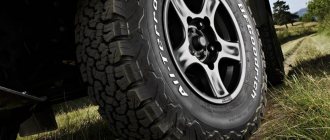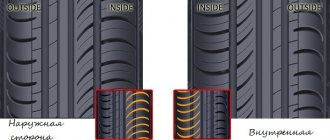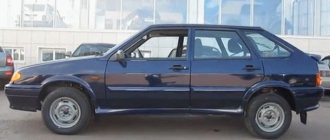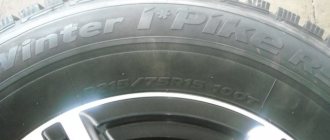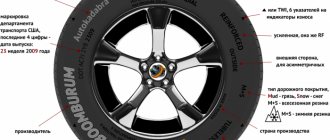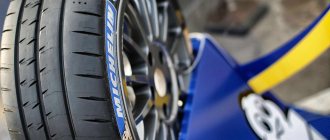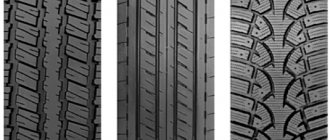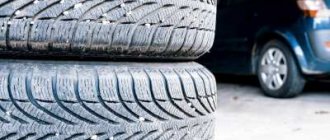Are you looking for a decoding of tire seasonality? The article contains a complete explanation of the seasonality designation on winter, summer and all-season tires.
Seasonality of tires is divided into: summer, winter and all-season. Summer, winter and all-season tires differ in parameters and many characteristics that affect the safety and comfort of movement. Being able to differentiate between different models is extremely useful because it makes it easier to choose the right type of tire. Below you will learn how to distinguish winter and all-season tires from summer tires and what are the characteristics of individual types of tires designed for certain seasons.
To indicate the seasonality of tires, the following markings are used:
- 3PMSF - a snowflake symbol against a background of three mountain peaks;
- M+S is an abbreviation for Mud+Snow, translated from English as “mud + snow”;
- AS, Any Season, All Season, R+W, AW, AGT - type of all-season tires;
- Rain, Aqua, Water, Aquatred, Aquacontact or painted umbrella are a type of rain tire that is suitable for driving on wet roads.
All designations on the sidewall of automobile tires, or rather the tire markings, are a set of technical parameters and other useful information indicating: date of production, country and manufacturing company, size, maximum permissible speed and load, type, installation method, operating conditions and seasonality.
Main advantages and disadvantages
A comparative description of the advantages and disadvantages will help you evaluate all-season tires. First of all, you don't need to buy two sets of tires. In addition, the cost of all-season tires is significantly less than winter tires. The price is approximately the same as the summer one.
Benefits of all-season tires
The main advantages of “all-season” tires are the following nuances.
- There is no need for seasonal change.
- There is no need to change tires frequently and worry about where to store them (read about how to properly store tires). Owners are only required to monitor the balancing and condition of the tires.
- Efficiency in changing winter conditions.
- In the conditions of the middle and southern zone, when snow replaces rain in winter, combined tires with a low tread and elastic tires significantly benefit.
- Low noise.
- On asphalt road surfaces they make virtually no noise and “go easily”.
Important Disadvantages
Of course, you should think carefully about whether the advantages outweigh the serious disadvantages of this type of tire. Such tires have a number of disadvantages.
- Continuous wear and tear.
- Using rubber year-round, in any weather, significantly reduces its shelf life. In summer, elastic rubber can melt under the influence of high temperatures. Due to this, Velcro and spikes deteriorate and fly off. In hot summers or harsh winters, such tires last 6–7 months.
- Ineffective in average winter conditions.
- This type of rubber is not suitable for winter in most regions of Russia: insufficient softness and elasticity cannot provide the proper level of adhesion to the surface. Small spikes and Velcro have less adhesive properties. Rubber that is not soft enough for a harsh winter hardens, cracks and can fly apart while driving.
- Not intended for aggressive driving.
- Professional drivers compare all-season tires to the effect of a “bald tire” during aggressive driving. Textured details make it difficult to drive off-road. Only new all-season vehicles will help you get out of the liquid mud.
- Increases the risk of losing control in extreme weather conditions.
- The poor maneuverability of a car on all-season tires makes it difficult to drive. They cannot cope with heavy snow or ice. There is also a high risk of tire damage on the road.
Additionally, we advise you to carefully study the article in which our expert talks about the sizes of passenger car tires.
Another important nuance that you should pay attention to when purchasing is the numbers and letters on the tires.
Colored lines on the tread
Almost all new tires have multi-colored stripes on the running side of the tires. They are also not of particular interest to the car owner and do not provide him with any useful information. The color coding of tires is intended to simplify their identification in storage areas.
When thousands of tires are stacked in a warehouse, a worker has no way to determine their type and size without seeing the markings located on the sidewall. It is with the help of these colored stripes, arranged in a certain order, that you can clearly identify the type of tire and its size.
Source fb.ru
The cold weather is coming, and almost every car owner is thinking about changing shoes for his car. Unfortunately, most people try to drive until the severest frosts on summer tires, and often it is these would-be drivers who make those around them suffer. The fact is that 95% of accidents occur precisely because summer tires cannot cope with slippery roads. But in recent years, so-called all-season tires have appeared on the markets of our country, which is what we decided to talk to you about in this article, or rather about its advantages and disadvantages.
Manufacturers of such rubber claim that you can ride on their wheels both in winter and summer, since they have a special tread pattern, but this is not entirely true. In our climatic conditions, you can drive on all-season tires most of the time, but only during snowfalls, you will be forced to change your shoes. The fact is that a huge disadvantage of such rubber is that it does not have studs, which is very important in our climatic conditions, especially if you park your car not in the garage, but right under the windows of your own house. It is also important that such tires do not have special Velcro that will allow you to move on a heavily snowy road, and the tread pattern will simply become clogged.
But besides the disadvantages, such rubber has a number of advantages, for example, it copes well with very wet roads, and therefore is recommended for use from early spring to late autumn. If we talk about driving it all year round, then this is unacceptable, unless you are a resident of warm countries, for example, Ukraine. By the way, it is there that it is wildly popular, but our climate does not allow us to save money and drive all year round on the same wheels.
Types of all-season tires
It must be borne in mind that all-season tires have their own classification and are divided into groups.
- The most common are models that are mainly adapted for driving on roads with satisfactory quality pavement and in the summer. These “all-season” vehicles are focused on maximum comfort and demonstrate good handling. At the same time, they are practically useless off-road or in deep snow.
- The second most popular are models for driving in high humidity and at high speed. They are distinguished by a V-shaped directional tread pattern, which provides excellent driving safety in rain or moderate icing. However, like the first ones, these tires have low flotation and do not handle snow well.
- A separate group includes all-season tires for various SUVs. Despite the fact that such tires can make a vehicle universal, they have a number of significant disadvantages, including high noise, accelerated wear, increased fuel consumption and reduced comfort.
Which tires are better, studded or not?
Before choosing this or that rubber, you must clearly understand in what environment and place you are going to use it. Tests have shown that, in general, the braking efficiency of both types is the same, but there are situations when one or another tire behaves worse or, on the contrary, better.
So, here's what the tests showed:
Studded tires
It behaves perfectly on roads with ice and with a mess of snow under which there is a crust of ice. In this case, the air temperature should not be lower than -15 °C. If you get on ice at lower temperatures, then on such rubber you will feel like you are on skates; the spikes will not cling to the hard surface.
Velcro
Accordingly, on an icy road down to -15, covered with loose snow, this tire is inferior to studded tires, but on a cleaned road at lower temperatures it wins. The braking distance will be shorter.
Conclusion: if you live in a city where the roads are cleared, then it is better to choose Velcro; if you often travel outside the city, where the roads are covered with snow in winter, your choice is studded tires.
On snow, both tires behave the same, but studded tires are much noisier! And also in some countries, studded tires are completely prohibited for use. And most importantly, you should not save, and if it wears out, it is better to buy a new one from a well-known manufacturer - after all, your and someone else’s life depends on it!
Many readers of my blog often ask me what is the difference between summer tires and winter tires, except for studs and tread. And why can’t you drive on winter tires in the summer and summer tires in the winter? I decided to reveal all these questions in the next article. For those interested, read on...
At first glance, they can be distinguished purely visually. The winter version has a coarser and deeper tread, as well as a completely different pattern, which, as a rule, is not similar to the pattern on the summer model, it also has studs for good grip on winter roads, for example with ice (by the way, there are now a lot of types of them, read). But the difference lies not only in the design and the presence of spikes, here guys everything is much more complicated.
Summer tires are made from a specific rubber compound that can withstand very high temperatures above zero. Asphalt is quite hot in summer, and the wheels must withstand these temperatures during acceleration and braking. It should be noted that it is much tougher than winter. But as the temperature drops below zero, summer tires become completely inelastic, and a car on such wheels can easily skid. A simple example: place a regular eraser in the snow in the cold and leave it for two to three hours. Then take an eraser and try to bend it. The eraser will lose its elasticity and break easily. The same thing happens with the summer version in the cold, it becomes dull and wears out very quickly, and it’s simply not possible to drive on such tires!
Remember!
Summer tire - must be used until the temperature is below zero, that is, minus one, we change it immediately, even if there is no snow.
The winter version also has a certain composition. Only the focus here is completely different. Winter does not please us with warm days; the thermometer is almost always in the sub-zero zone, sometimes even exceeding -35. And the task is to remain elastic in such frosts and provide maximum grip on the road. The difference between winter tires and their opponents is their softness, that is, they are much softer than summer tires. And the high tread also fights snow and ice. Therefore, it looks much more massive, with a high tread. You just need something to cling and dig up the snow. However, it is absolutely not adapted to above-zero temperatures, and especially to rain. A car with spikes in puddles is like a “cow on ice”; it is difficult to control. And hot asphalt quickly wears out soft winter tires. Try to heat the same eraser and run it across the asphalt; it will leave a trail of small pieces of rubber behind it; when heated, it collapses very quickly. About the same thing happens with a tire; its soft base literally melts in the heat, on hot asphalt.
Remember!
This type should be used up to the plus mark. If the snow has melted and it’s already plus one at night, then it’s better to change it.
Sometimes it may seem, especially when driving on asphalt, that winter tires are much harder than summer tires, but this is not the case. The hum that occurs when the car is moving is caused by the studs and high tread, not by the harshness.
Now guys, this is a very useful comparative video, although it’s in English, but you can catch the main points, let’s take a look.
How to choose all-season tires
From the point of view of purchasing all-season tires, you should look at the following selection criteria:
- all-season price,
- durability/service life of tires and service life warranty,
- local weather in your region,
- type of vehicle (Gazelle, passenger car or SUV),
- driving style,
- all season tire size.
These considerations will help you choose the best all-season tires at a good price. Look for tread types and speed ratings that match the type of riding you do, but know that better performance also comes at a higher price.
All-season tires are an excellent choice for the late spring, summer and early fall months. They perform well in dry conditions and can withstand wet weather during these seasons. But since in most regions of Russia winters are cold, long and often bring serious adverse weather conditions in the form of snowstorms and snowfalls, winter tires are safer today.
All-season tires for passenger cars
It is also worth considering all-season passenger tires. Universal tires have appeared on the tire market for a relatively long time, and as sales figures show, they are quite popular among motorists. First of all, this is due to a certain fact of saving money, because when purchasing such tires, there is no need to purchase a second set.
The best all-season passenger car tires for all types of vehicle drive. Models with an aggressive tread pattern are ideal for driving not only on asphalt, but also off-road. A good tire should combine reliability and stable stability while driving as additional advantages. The pressure inside the wheel is distributed in such a way that the tire has an optimal spot size at the point of adhesion to the road surface.
It's time to sum up a little. As positive reviews about all-season tires show, motorists who drive such a set of tires are satisfied with the purchase. And to understand whether it is possible to drive on all-season tires all year round, you need to take into account several factors: climatic conditions and driving style. Such tires are absolutely not suitable for aggressive driving; they are also not suitable for operation in very negative temperatures or driving on hot asphalt.
Source carsmotion.ru
All-season tire manufacturers
Well-known manufacturers of all-season tires:
- Hankook;
- Michelin;
- Bridgestone;
- Yokohama.
All-season tire from Continental
All-season tires Bridgestone Dulere 840
We recommend: How to care for car paint in winter?
All-season tires were first produced at the Goodyear plant in the USA. The company still holds a leadership position in this segment and provides the widest range of all-season tires.
Manufacturers' information or logo is applied to the side of the wheel. Its model is also indicated here, and the country of origin is written closer to the rim, in smaller font.
General concepts
So, we open the owner's manual to find out what tires we need to buy. Here we find tire options for different conditions. They depend on the following indicators:
- Season – tires are available in summer, winter and all-season;
- Engine – type of power plant and its power;
- Discs - rubber is selected depending on the material from which the discs are made.
Tire markings are applied to all tires. From it you can find out the size, speed and load index, as well as the manufacturer. A tire consists of a bead, carcass, side part, tread and breaker layers. If you turn the side of the tire towards you, you will see the markings on the tires in the following sequence: width, profile and diameter. The example below shows a tire with a width of 225, a profile of 45Z and a diameter of R17:
All-season tire markings
All-season tires with full “All Seasons” or “Any Weather” inscriptions. The following abbreviations are also used: AS (All Seasons) and AW (All Weather). Some manufacturers use the “M&S” and “M+S” markings for summer tires, although most companies designate all-season tires with these letters. Mud (M) translated from English means “dirt”. Snow (S) translates as “snow”.
Some manufacturers are using new labeling methods. It is used for improved summer models. The current level of technology development does not allow us to create a universal tire that will perform equally well on both summer and winter roads. Therefore, summer ones, as far as possible, are loaded with innovations that allow them to be used in the fall or in mild winter conditions. An example is all-season tires from Michelin. The company has released improved models of the Energy line. Marking R+W (Road + Winter). Translated, it looks like “Road + Winter.” In fact, it means that the tires are summer, but according to some characteristics they are suitable for use in winter.
Selection for SUV or crossover
We told you how to distinguish winter tires from summer tires - by the snowflake icon. However, to choose shoes for a non-trivial car, this knowledge may not be enough. When purchasing wheels for a crossover, you should imagine where the car will spend most of its time. If in the city, then standard tires with the designation AW (All Weather or Aqua - improved drainage and increased resistance to aquaplaning) are a good choice.
If the car goes beyond the definition of an SUV and you are planning trips into nature, then it is better to give preference to sets with a developed tire tread, improved lugs and increased cross-country ability. Such kits are designated by the letters AT - All Terrain.
For real off-road vehicles, special tires like Bridgestone Dueler are used, which have proven themselves in combat conditions and have high load resistance and excellent grip. This set is more expensive than the standard one, but its price is justified by its excellent qualities.
Pros and cons, features of all-season tires
All-season tires are universal car “shoes” with some of the performance properties of winter and summer tires. One of the advantages of all-season tires is that you can use one set of tires (with certain restrictions) instead of two, save money and time on tire fitting, and use them all year round. Suitable for driving in the southern regions of the Russian Federation. They are used in climatic zones with short and little snowy winters and small temperature changes. The disadvantage of all-season tires is that they are inferior in grip characteristics to both summer and winter specialized tires. Poorly suited for use in severe frost and sultry heat.
Marking features
All-season tires, depending on the manufacturer and model, are marked with the abbreviation AS or the inscription All Season, All Weather, Any Weather, Tous Terrain, etc.
As an additional indication of the high efficiency of all-purpose rubber in resisting aquaplaning, the inscription Rain (Aqua) or a small umbrella is applied. Otherwise, the marking systems for “all-season” and seasonal tires correspond to each other.
However, the presence of one of these designations does not guarantee that tires are allowed for year-round use. According to the new requirement specified in the Technical Regulations for the countries of the Customs Union, the model of all-season tires must have two certificates of compliance (summer and winter standards).
Distinctive features
Unique chemical composition of the rubber mixture
Tire manufacturers use special components and additives to obtain average grip characteristics on dry summer roads, winter slush, and slippery road surfaces. The rubber mixture is resistant to temperature changes, but is not suitable for use at very low and high temperatures.
Universal tread pattern
Most year-round tires have a summer tread pattern with increased groove area and depth. Designed for mild European winters. Well adapted for use in dry weather on high quality roads. Manufactured by Pirelli and Goodyear.
There are also tires with a “gossamer” tread with numerous sipes. These all-season tires are manufactured by Hankook.
Another tread option is an asymmetrical pattern with different inner and outer sides. The first is designed for effective grip on wet roads, the second - for precise control and reliable grip on dry road surfaces.
All-season tires with a more aggressive V-shaped tread pattern perform best in wet weather (summer and winter).
About All Terrain Tires
SUV owners mistakenly believe that universal tires marked A/T are all-season, suitable for summer and winter use. In fact, this is a special subclass of tires designed for different road surfaces.
The All Terrain tread is characterized by the presence of large blocks, between which there is a large amount of free space (for quick and effective removal of dirt).
Universal all-terrain tires are used on asphalt roads in the city and rural gravel roads. Suitable for driving on light off-road conditions, small muddy and swampy areas. Not intended for use in winter.
We recommend: What to do if the air conditioner in your car does not turn on?
Advantages
- saving free time on tire fitting in the off-season;
- buying one set of tires instead of two;
- acceptable performance characteristics with infrequent use of the vehicle in winter (mainly in urban areas).
Flaws
- accelerated tire wear;
- insufficient traction on snowy and icy roads in severe frost;
- not recommended for use on rear-wheel drive vehicles;
- Due to versatility, the level of grip, control reliability and braking performance suffer in different weather conditions. They are inferior in terms of road grip and braking properties to both high-quality summer and winter tires.
Summer tire in winter
These are tires for extremely warm temperatures, they should be rigid and relatively light, they should not have a rough and high tread, but effectively remove moisture. A hard tire in summer is a salvation, it “doesn’t melt or float” at above-zero temperatures, hard compounds are used to the maximum, heating up from hot asphalt, the tire effectively engages with the road surface, and there is no increased wear. However, in winter (already at zero), such rubber begins to harden, in addition to the fact that it itself is “hard,” under the influence of negative temperatures it becomes even harder, the tread cannot effectively adhere to the road surface (it practically does not wrinkle), and Even more so when dealing with snow or ice, such a tire literally rolls like “on skates”, the braking distance increases and the grip on the road deteriorates.
Features of all-season tires
The car market responds quite quickly to the needs of car enthusiasts. That is why the concept of universal all-season tires that are suitable for any season was developed. The result is a symbiosis of summer and winter tires, which has the characteristics of both types. However, it was still not possible to realize all the advantages without the disadvantages.
It is possible to better understand the specifics of all-season tires only after some analysis of seasonal tires.
- To make the summer version, hard rubber is used. Low, wide tread with different types of patterns prevents premature tire wear and provides the necessary coefficient of rubber adhesion to the road surface. A high tread will significantly increase the mass, and therefore reduce the contact area. It is recommended to use this type of rubber at temperatures not lower than +7 °C. Otherwise, the material becomes more rigid, wear increases, and the risk of tire damage and accidents increases.
- Winter tires are made from softer rubber. The softness of the material provides better grip on wet or slippery surfaces. The soft elastic material tolerates low temperatures well and does not harden. On winter tires, tread patterns are applied more deeply, and Velcro is also applied - a small zigzag tread pattern - or studs (read about which is better - studs or Velcro). In warm weather, using winter tires makes driving difficult, increases fuel consumption, and the tire wears out faster.
- All-season tires are made of medium-hard elastic rubber. In terms of hardness, this type of rubber occupies an intermediate position between soft winter and hard summer. The tread is relatively low, the pattern is applied wider and deeper than the summer one, but not as deep as the winter one. The number of spines has been reduced and they are much smaller in size. The size of the Velcro is also reduced, they have light adhesive properties. The optimal temperature range for such tires is from +5 to -10°C. Use in other temperature conditions reduces the performance of the tires.
Additionally, we recommend reading the article by our qualified expert on the law on winter tires.
We also recommend reading our specialist’s article, in which he talks in detail about how to choose winter tires for a car.
You might also be interested in this article where our expert talks about how to select and install tracks for a passenger car.
Tires for any season. Is it possible?
All-season tires combine the characteristics of summer and winter tires. It saves the driver from seasonal changes, but it is a mistake to think that it can be used instead of full-fledged winter and summer tires.
These tires are designed for countries with mild climates, where the air temperature in winter does not drop below – 7 °C, and the summer heat is kept within reasonable limits (no more than +25 °C).
Winter tires have a high tread that protects from snow and deep grooves to drain water. Summer tires provide good grip due to a large contact patch with the surface.
Winter tires are softer and do not “tan” in severe frost, while summer tires are stiffer and do not melt under high temperatures.
The combination of these completely opposite qualities in one product is impossible, so all-season tires can only be used in temperatures ranging from -5...-7 °C to +25...+27 °C.
Main pros and cons
The main advantage of all-season tire sets is efficiency. It was previously mentioned that when purchasing an “all-season” tire, you do not need to think about purchasing replacement tires, their timely installation and proper storage. This allows the vehicle owner to receive immediate benefits in the form of reduced costs for purchasing a second set.
Such a decision is not without meaning if you do not plan to use it for a long time before selling the car and purchasing additional “shoes” will be an unreasonable waste of money. In addition, all-season tires are often cheaper than specialized models, which is explained by the marketing strategy of companies producing such tires with an eye on economical drivers.
Among other things, by equipping your car with “all-season” service, you won’t have to wait in line at a service station in the off-season.
We also note that various tests indicate that all-season tires behave much better in “mild” winter conditions than tires designed for use in cold weather. Such results are due to the frequent replacement of ice and snow on the roads with dry asphalt, and in these areas winter tires wear out more intensively, losing their advantage. Well, when the snow melts, the “all-season” system does a better job of draining water a priori.
As for the disadvantages of year-round models, there are much more of them than the positive features. Let's start with the fact that in any weather, such tires work satisfactorily, but not great. While specialized tires are adapted to specific conditions in which they perform excellently, “all-season” tires perform approximately “C.”
You also need to take into account that universal tires are mainly aimed at measured, sedate driving, and its operation at high speeds is downright dangerous. For this reason, companies often underestimate the permissible load and speed limits for such models.
We recommend: Rating of the best oils for high mileage engines in 2022
When compared with seasonal tires, all-season tires are certainly inferior to them in cross-country ability, which limits their use on wet soils and heavily snow-covered roads.
All-season tread features
To choose the right all-season tires, you should also consider the tread. Let's look at how it differs from more highly specialized tires.
Typically, tires for all-season use are based on a “summer” tread. Often, rain tires are used, which are stable on slippery roads. It is reinforced with grooves with greater depth, the blocks are made more massive, and shoulder elements are added. The result is a tread that serves approximately equally well in snow and rain.
Common options include a “web” or an asymmetrical directional pattern. “Gossamer” is distinguished by a large number of slots imitating lamellas, which gives good grip on winter roads, and the placement of the slots on the edge ensures high-quality water drainage in summer. The asymmetrical pattern allows you to combine two types of tread in one tire, providing the ability to feel the car equally on any type of surface.
All-season tires and legislation
Is it possible to drive an all-season vehicle in winter and summer? The 2019 legislation clearly regulates the months of use of winter and summer tires. But our legislation does not mention all-season tires, and regarding winter tires, we are not talking specifically about tires for winter, but about studded tires. In particular, in summer it is prohibited to use any winter tires, and all-season tires are not winter tires. But in winter, the use of summer tires is prohibited, as well as tires with a residual tread depth of no more than 4 mm (clauses 5.5 and 5.6.3 in the bill, called the Technical Regulations). The only point is that the all-season vehicle must have one of the markings:
- M+S,
- M&S
- M.S.
- designation with a sign in the form of a mountain peak with three peaks and snowflakes inside it (see figure below).
Thus, the law does not prohibit you from driving on all-season tires all year round, regardless of conditions.
Is it worth buying an “all-season” set, or is it better to have two standard sets?
It is advisable to use all-season tires all year round in the following cases:
- If in your country winter temperatures do not fall below 0 °C and the heat does not exceed +25 °C.
- If you rarely travel by car and can leave the car in the garage when weather conditions are not suitable for comfortable movement.
You should use such tires only in suitable temperature conditions, and under no circumstances should you ride on all-season tires in a snowstorm, ice or thirty-degree heat, as this may be unsafe.
In Russia, Ukraine, Kazakhstan and other countries with a similar climate, you must have a set of winter and summer tires. It must be replaced in accordance with weather conditions (from +5...+7 °C).
Marking of all-season tires. Analysis by example
All-season tires are usually marked with the inscription AllSeasons (abbreviated as AS). Sometimes you can see the designation of all-season tires on tires
like AnyWeather or AllWeather, which is basically the same thing. It is also indicated by graphic drawings:
All-season designation on the sidewall
Let's look at the designations of all-season tires using an example. For analysis, let’s take tires with the following parameters:
LT 275/70 R18 124 Q, Tubeless, All weather,Right
- LT stands for Light truck and is used in American markings. European tires will not have this inscription;
- 275/70 – rubber profile. Width 275 mm and height 70%
- R – radial structure of the tire;
- 18 – landing diameter;
- 124 – load index, which means that the load capacity is 1600 kg;
- Q – maximum permissible speed on this tire is 160 km/h;
- Tubeless - tubeless tire;
- Allweather - all-season;
- Right – asymmetrical, directional.
Explanation of markings
Main characteristics: size, profile, type and design of the tread
All-season tires, like regular tires, have the following parameters:
- Profile. The width and height indicators are taken into account. The width is in millimeters, and the height is a percentage of the width. For example, 205/55, where 205mm is the width of the tire, and 55 is % of 205, that is, 92.25 mm.
- Diameter of the seat. Measured in inches and depends on the car model. It is marked on the side of the wheel in the form of numbers (13, 15, 20, etc.).
- Design. It can be diagonal (rarely used) and radial. Denoted by the letters D and R respectively..
- The side is indicated on the asymmetrical treads. Marked with the inscriptions Inside and Outside. Directional wheels have an arrow indicating the direction and the words Rotation.
- Temperature conditions. Indicated in the letters A, B and C, where A is the best indicator of heat resistance at high speeds.
- Maximum pressure. Expressed in kilopascals or bars.
Related link:
TOP 10 budget tires for winter 2018-2019
Special badges on all-season tires
External side marking
The manufacturer can apply to all-season and other additional descriptions, for example, the material from which the cord is made (nylon, polyester, steel) or the wear resistance of the rubber, which is expressed in numbers from 100 to 500.
Speed table
Speed indicators are indicated by letters. The marking indicates the ability of the tires to reach a particular speed.
| Maximum speed (km/h) | Speed index |
| 120 | L |
| 130 | M |
| 140 | N |
| 150 | R |
| 160 | Q |
| 170 | R |
| 180 | S |
| 190 | T |
| 200 | U |
| 210 | N |
| 240 | V |
| 270 | W |
| 300 | Y |
| More than 300 | Z |
Tire load table
The load index determines the carrying capacity of the vehicle
| Index | Weight, kg | Index | Weight, kg | Index | Weight, kg | Index | Weight, kg | Index | Weight, kg |
| 62 | 265 | 75 | 387 | 88 | 560 | 101 | 825 | 114 | 1180 |
| 63 | 272 | 76 | 400 | 89 | 580 | 102 | 850 | 115 | 1215 |
| 64 | 280 | 77 | 412 | 90 | 600 | 103 | 875 | 116 | 1250 |
| 65 | 290 | 78 | 425 | 91 | 615 | 104 | 900 | 117 | 1285 |
| 66 | 300 | 79 | 437 | 92 | 630 | 105 | 925 | 118 | 1320 |
| 67 | 307 | 80 | 450 | 93 | 650 | 106 | 950 | 119 | 1360 |
| 68 | 315 | 81 | 462 | 94 | 670 | 107 | 975 | 120 | 1400 |
| 69 | 325 | 82 | 475 | 95 | 690 | 108 | 1000 | 121 | 1450 |
| 70 | 335 | 83 | 478 | 96 | 710 | 109 | 1030 | 122 | 1500 |
| 71 | 345 | 84 | 500 | 97 | 730 | 110 | 1060 | 123 | 1550 |
| 72 | 355 | 85 | 515 | 98 | 750 | 111 | 1090 | 124 | 1600 |
| 73 | 365 | 86 | 530 | 99 | 775 | 112 | 1120 | 125 | 1650 |
| 74 | 375 | 87 | 545 | 100 | 800 | 113 | 1150 | 126 | 1700 |
Marking of demi-season tires
At times, all-season tires are confused with winter tires. This is due to the similarity in the designation of the type and type of product. According to international marking and designation standards, all tires that are allowed to be used in winter are marked “M+S” (Mud & Snow - snow and mud). However, tire manufacturers add a snowflake and mountain symbol to indicate a product that should be used exclusively in winter. All-season tires are marked only with the abbreviation “M+S” without any symbol.
Marking that is applied to the tire
- You need to pay attention to the tire manufacturer and its model. These inscriptions are applied to the side surface of the tire. (Rosava BC-17, Cinturato P 7).
- Tire carcass design. Usually indicated in English (TUBELESS RADIAL - tubeless radial).
- If the tire has an asymmetric tread pattern, then there must be an inscription that indicates exactly how the tire should be installed.
- DOT control. Department Of Transportation – Department of Transport of the most democratic country in the world. This marking is an indicator of the safety of using the tire and a kind of product quality standard. Today, most countries in the world do not allow the sale of tires that do not have a certificate of passing this examination. The coded designation here indicates: manufacturer and manufacturing plant, size, production date and other information for the manufacturing plant.
- The ECE certificate (Economic Commission for Europe) indicates that the tire has been tested for compliance with physical characteristics, dimensional compliance and speed limits. The designation consists of the letter “E” and numbers that indicate the country that issued the certificate, as well as the individual tire code (E3 123456).
- In accordance with Directive 2001/43 of the European Union, the tire must be certified to pass a noise test. The marking is located near the ECE designation (0123456-7 e8).
- WI (tread wear indicator - tire wear indicator). Located at the bottom of the tread grooves in the form of strips of projections 1.6 mm (2/32 inch) high, usually red, but another color can be used. When the tread wears down to the level of the indicator, its further operation is unsafe and the tire must be replaced.
Consequently, having information about the passage of standard control of tires, you can not only distinguish a fake from a quality product, but also select a kit to meet your own needs.
Date of manufacture
It is necessary to pay attention to the date of manufacture not only when purchasing used tires, but also when purchasing new ones. The thing is that unscrupulous sellers often buy up tires at a low price that have been lying in warehouses unclaimed for years.
Tire manufacturers claim that long-term storage causes tires to lose their shape and performance properties. Naturally, there can be no talk of any safety when using such rubber.
Finding out the release date of a tire is easy. The marking is also applied to the side surface and consists of four numbers indicating the week and year. For example, the inscription 1609 indicates that the tire was manufactured in the 16th week of 2009. Almost all global tire manufacturers adhere to this marking, so its absence on the sidewall is the first sign of uncertified products.
By the way, until 2000, the date was indicated by five digits, the first two of which were the week number, and the remaining three were the production year code.
What is all-season
All-season tires are tires that perform best in moderate conditions. Compared to winter tires or summer tires, all-season tires handle a variety of weather conditions better than others. They are versatile, which is good news. The bad thing is that this versatility means, according to many reviews of the all-season vehicle, that it behaves poorly in both heat and cold.
Pros and cons of all-season tires
But above we noted not the only advantages and disadvantages of the all-season model. In fact, rubber has its own characteristics, and the requirements for operation in different weather conditions dictate to its manufacturers the high quality of materials from which such rubber must be made.
| pros | Minuses |
| Savings due to year-round use: no need to keep 2 sets of tires for one car and pay for tire fitting services | Reduced ride efficiency at temperatures averaging below 2-10 oC |
| Ride comfort | Not suitable for severe frost or snowfall |
| Reduced noise level in winter | Poor performance on ice |
| Versatility | Higher price for all-season tires than for summer tires |
| Excellent wet weather performance for most all-season tires | |
| Longer tread life |
However, individual performance will vary with the different models of tires available. Some tires are also labeled M+S, which means they are better suited for driving in mud and snow. These tires will have better traction.
Also, do not forget that the behavior of all-season tires on SUVs, as well as small trucks like the Gazelle, will be different. In general, all-season tires feel good on UAZ Patriots and other models in sizes 75 r16c and above, that is, with not very wide dimensions and a fairly high profile and radius, but the leading criterion is, of course, the weight of the vehicle itself, which uses all-season tires tires.
How are these tires designed?
When tire manufacturers develop all-season tires, the main factors they consider are:
- tread wear durability,
- Possibility of water drainage in wet conditions,
- road noise,
- ride comfort.
Other factors, such as cold weather, play a factor, but to a lesser extent.
Tread wear life is rated based on average use under normal operating conditions for various vehicle types. For all-season tires, it depends mainly on the composition and density of the rubber, and affects the ability to maintain grip with a minimum amount of wear. A harder rubber compound will have longer tread life but will lose traction more easily, while a softer rubber compound will have better traction in a variety of conditions but will be more susceptible to wear.
The ability of all-season rubber to remove water from its tread prevents a condition known as hydroplaning. Hydroplaning is when the tire's contact patch is unable to clear the water on the road quickly enough to contact the road surface, and essentially rides on top of the watery surface. This is a very dangerous phenomenon for the driver and passengers of the car. Tire manufacturers design their tread blocks so that water flows from the middle of the tread outward. The channels and lines cut into the tread blocks are known as "grooves".
A tire's tread pattern also plays a role in the amount of noise transmitted into the vehicle's interior. Tire designs include alternating or stepped tread blocks to minimize droning noise from road contact. Road noise is an issue at highway speeds, and poorly designed tires are noticeably noisier than higher quality tires.
The rubber used in an all-season tire is resilient and stiff enough to create harsh impacts that transmit vibration from the impacts into the cabin. To improve ride comfort, tire manufacturers strategically design the sidewall to be softer and allow the tire to go over potholes and potholes more smoothly. In general, the smaller the sidewall, called the profile, the stiffer your ride will be. Moreover, the profile is measured as a percentage of the tire width, and its larger indicator does not always mean that the profile is actually larger. For example, passenger car tires of size 235 65 r17 will be higher than tires 215 65 r16c, but lower than 205 70 r15. The latter are often used on SUVs and crossovers; such tires are installed on the Niva, some UAZ models and foreign SUVs.
Speed index
This value indicates the maximum permissible speed of the car at which the tires are guaranteed to cope with their tasks. Despite the fact that manufacturers almost always overestimate this parameter, it is strongly not recommended to accelerate your car to this speed. It should also be taken into account here that foreign companies producing tires have no idea about the condition of our roads, so in no case should you try to check the indicated speed indices. On tires, the maximum acceleration designation is marked with one letter of the Latin alphabet, indicating the permissible speed. We most often have rubber marked with the following letters:
- “L” – 120 km/h;
- “M” – 130 km/h;
- “N” – 140 km/h;
- “P” – 150 kph;
- “Q” – 160 km/h;
- “R” – 170 km/h;
- “S” – 180 km/h;
- “T” – 190 km/h;
- “H” – 210 km/h;
- “V” – 240 km/h;
- “W” – 270 km/h;
- “Y” – 300 km/h.
For sports cars and cars participating in various competitions, a special tire designation is provided. The “ZR” speed index, for example, indicates that the rubber can be used in critical speed conditions, i.e. from 240 km/h.
Types of rubber for studding
Rubber subject to studding refers to tires that must be studded, have factory holes in the tread, the properties and declared characteristics of which require operation only with installed anti-skid studs.
Suitable for studding are tires that can be studded if they have suitable characteristics that allow operation at low temperatures.
Rubber with holes
Tires with holes after installing studs are intended for use in winter. In most cases they carry the 3PMSF winter label and have winter-tested performance. In such tires, the tread sipes have pattern lines and massive platforms for securely attaching the studs. The tire material is soft enough that at subzero temperatures the sections of rubber with spikes and lamellas bend, providing good grip on the road. In this case, studding of tires is provided for by the design of the tire, and the question of whether this is worth doing has already been half resolved in favor of installing anti-skid elements. They will help the driver drive up an icy slope, as well as effectively brake on a snowy surface.
Tires without holes
On the rubber tread, which is suitable for installing studs, as a rule, there are no holes pre-made during vulcanization. When working with it, we ourselves draw up a diagram of the holes for the tenons, taking into account, among other things, the operating features of this particular batch.
The simplest, primary indication that a tire is suitable for studding is the presence of the all-season M+S marking, which means it is suitable for use in mud and snow conditions. The main purpose of such rubber is to use it on various types of roads in any climatic conditions at air temperatures from –45 ˚C to +10 ˚C, which is regulated by GOST R 54916–2012.
It will not be possible to stud friction tires - Velcro - this is due to the density of the tread pattern, the design of the lamellas and the properties of the product material
Most often, studded all-season tires are used for use on Class C commercial vehicles - this is a large segment where the choice of winter tires with factory holes is quite limited. In addition, all-season tires, when equipped with studs, become the key to handling for SUVs.
Other designations
But in addition to the main designations, rubber very often has other markings:
- “Max Pressure” with a digital indicator - indicates the maximum permissible pressure in the tire (usually in kilopascals or bars);
- “Inside”, “Outside” - indicate that the tires are asymmetrical;
- “Rotation” with a directional arrow - indicates that the tire has a directional design and must be installed accordingly;
- “Temperature” A, B, C – heat resistance index (A – maximum);
- “Traction” A, B, C – braking index, which determines the effectiveness of emergency braking (A – the best);
- “Tubeless” – tubeless tire;
- “Tube Type” – a tire designed for use with a tube;
- “RSC” are special tires with Run Flat System Component technology, which allows you to continue driving your car even if the tire is punctured or cut. Such rubber can travel up to 100 km in the complete absence of internal pressure;
- “TWI” is an inscription indicating that the tire has a special “beacon” located in the groove between the tread, which is an indicator of its wear;
- “PR” is the strength of the tire carcass, measured by the number of layers of rubber.
High-quality tires are the key to safe driving
The choice of tires is a purely individual matter, but it should be based on generally accepted standards. This includes the composition of the mixture, marking of all-season tires, tread type, cost of the product, manufacturer, etc. Therefore, before making a purchase, it is recommended to familiarize yourself in detail with the specifics of the rubber and compare it with the specific operating conditions. In this case, you will be able to choose tires that maximize safe movement on both dry and wet asphalt.
But be that as it may, seasonal tires do their job better. If the issue of safety is acute, then it is better to give preference to such products.
General rules for choosing car tires
It is almost impossible to answer unequivocally which tires are best. When choosing, you should look at the operating features and driving style. The technical requirements of the car are taken into account, because the wheel and tire must easily fit into the fender liner.
It is worth understanding the markings of tires. Let's see, for example, what this designation says: 175/65R14 86H. This marking is deciphered as follows.
- 175 – profile width in mm.
- 65 – ratio of profile height to its width. Shown as a percentage.
- R – radial design.
- 14 – internal landing diameter.
- 86 – permissible load index.
- H – index demonstrating maximum speed.
There are no special requirements for all-season tires. First of all, you should look at the data specified in the operating manual for your car.
All-season tires are not a complete replacement for winter or summer tires. It should only be used in mild winter conditions. When choosing, take into account the operating characteristics, as well as the nuances of the road surface.
How to disassemble a tubeless wheel?
How to dismantle a car wheel?
How to repair a tire yourself
How to remove and install wheel covers
Tire repair kit: when it comes in handy, composition, how to use
Date of production of tires: where is it written, is it worth paying attention to it when purchasing
Wheel valve - types, device, selection rules
H/T tires - features and purpose of models
Where to begin
The vehicle's owner's manual usually contains some recommendations for the correct selection of tires. This takes into account the type of wheels (steel or alloy), season of use (summer, winter), as well as the standard factory size. Naturally, not every driver adheres to such recommendations, which is why the car may be equipped with tires that, in terms of their parameters, do not meet the requirements of the manufacturer.
So it’s better to start by studying the standard requirements for tires of a certain brand of car. If you are satisfied with the type and size of the tires that are installed on the car, you simply need to rewrite all the existing designations.

